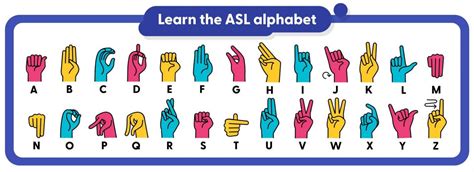Sign language, the harmonious dance of hands, conveys emotions, thoughts, and experiences with an eloquent grace that transcends spoken words. It’s a vibrant tapestry of gestures, expressions, and movement that weaves together the fabric of communication for millions worldwide.

Importance of Sign Language: Empowerment and Accessibility
Sign language is not merely a substitute for spoken language but an integral part of deaf and hard-of-hearing communities. It empowers individuals to fully participate in society, fostering inclusivity and bridging gaps between different worlds. In 2020, the World Federation of the Deaf estimated that over 72 million people globally use sign language as their primary means of communication.
Benefits of Learning Sign Language
Embracing sign language offers a myriad of benefits that extend far beyond the realm of deaf and hard-of-hearing individuals.
Cognitive Development: Studies have shown that learning sign language enhances cognitive abilities, improves memory, and boosts spatial reasoning.
Language Development: Sign language provides a solid foundation for language acquisition, enabling young children to develop a rich vocabulary and strong communication skills.
Social Inclusion: Learning sign language fosters a sense of belonging and promotes empathy, breaking down barriers between different cultures and communities.
Career Opportunities: Sign language proficiency opens doors to diverse career paths in fields such as healthcare, education, and interpreting.
Table 1: Benefits of Learning Sign Language
| Benefit | Description |
|---|---|
| Cognitive Development | Enhances cognitive abilities, improves memory, and boosts spatial reasoning |
| Language Development | Provides a solid foundation for language acquisition, enabling young children to develop a rich vocabulary and strong communication skills |
| Social Inclusion | Fosters a sense of belonging and promotes empathy, breaking down barriers between different cultures and communities |
| Career Opportunities | Opens doors to diverse career paths in fields such as healthcare, education, and interpreting |
How to Learn Sign Language: A Step-by-Step Approach
Embarking on the journey of learning sign language is a rewarding experience that requires patience, dedication, and a playful spirit. Here’s a step-by-step guide to get you started:
-
Explore Online Resources: Immerse yourself in sign language with online platforms such as Gallaudet University’s free ASL dictionary (https://www.gallaudet.edu/asl-dictionary) and DeafTEC (https://www.deaftec.org).
-
Attend Classes: Join sign language classes offered by community colleges, universities, and deaf and hard-of-hearing organizations. Structured lessons provide a solid foundation and allow for interaction with other learners.
-
Practice with Deaf or Hard-of-Hearing Individuals: The best way to refine your sign language skills is to practice with native signers. Engage in conversations and observe their gestures, expressions, and body language.
-
Use Technology: Utilize mobile apps and online videos to supplement your learning. Apps like Marlee Sign (https://www.marleesign.com) and Signily (https://www.signily.com) provide interactive exercises and personalized lessons.
-
Be Patient and Persistent: Learning sign language takes time and effort. Don’t get discouraged by setbacks, and keep practicing regularly. Set small, achievable goals to maintain motivation.
Innovative Applications of Sign Language
Beyond its traditional use, sign language has sparked creative innovations that enhance communication and foster inclusivity:
Sign-to-Speech Translation: Technology is bridging the gap between sign language and spoken language. Devices like Ava (https://www.ava.me) and InnoCaption (https://www.innocaption.com) translate sign language gestures into spoken words, facilitating communication in real-time.
Sign Language in Virtual Environments: The rise of virtual reality and augmented reality opens up new possibilities for sign language. Avatars in virtual worlds can now sign, enabling deaf and hard-of-hearing individuals to socialize and interact in immersive environments.
Signalyzers: Signalyzers, intelligent systems that analyze sign language gestures, are revolutionizing healthcare. They can detect early signs of neurological disorders by monitoring sign language fluency and accuracy.
Table 2: Innovative Applications of Sign Language
| Application | Description |
|---|---|
| Sign-to-Speech Translation | Technology translates sign language gestures into spoken words, facilitating communication in real-time. |
| Sign Language in Virtual Environments | Avatars in virtual worlds can now sign, enabling deaf and hard-of-hearing individuals to socialize and interact in immersive environments. |
| Signalyzers | Intelligent systems analyze sign language gestures, detecting early signs of neurological disorders by monitoring sign language fluency and accuracy. |
Pros and Cons of Learning Sign Language
Pros:
- Empowerment for deaf and hard-of-hearing individuals
- Enhanced cognitive and language development
- Foster social inclusion and empathy
- Opens doors to diverse career opportunities
Cons:
- Requires dedication and consistent practice
- May be challenging for individuals with physical limitations or visual impairments
- Availability of sign language resources may vary depending on location
Table 3: Pros and Cons of Learning Sign Language
| Pro | Description |
|---|---|
| Empowerment for deaf and hard-of-hearing individuals | Sign language enables deaf and hard-of-hearing individuals to communicate effectively and participate fully in society. |
| Enhanced cognitive and language development | Studies have shown that learning sign language enhances cognitive abilities, improves memory, and boosts spatial reasoning. |
| Foster social inclusion and empathy | Learning sign language promotes a sense of belonging and empathy, breaking down barriers between different cultures and communities. |
| Opens doors to diverse career opportunities | Sign language proficiency can lead to career paths in fields such as healthcare, education, and interpreting. |
| Requires dedication and consistent practice | Learning sign language requires patience, dedication, and a consistent practice routine. |
| May be challenging for individuals with physical limitations or visual impairments | Individuals with certain physical limitations or visual impairments may face challenges in learning sign language. |
| Availability of sign language resources may vary depending on location | Access to sign language resources, such as classes and interpreters, may vary depending on geographical location. |
Table 4: Differences Between Sign Language and Gestures
| Characteristic | Sign Language | Gestures |
|---|---|---|
| Purpose | Primary mode of communication for deaf and hard-of-hearing individuals | Enhance or supplement spoken communication |
| Structure | Complex system with grammar, syntax, and vocabulary | Less formal, often used spontaneously |
| Usage | Used in a wide range of situations, including education, employment, and social interactions | Typically used in specific contexts or situations |
| Recognition | Recognized as a distinct language by many countries and organizations | May not be universally recognized or standardized |
Conclusion
Sign language is a dynamic and vibrant language that unlocks a world of communication and connection. Its importance extends far beyond the deaf and hard-of-hearing community, fostering inclusivity, promoting cognitive development, and breaking down barriers between different cultures. By embracing sign language, we can create a truly accessible and equitable society where everyone has the opportunity to express themselves and participate fully in the tapestry of human experience.
